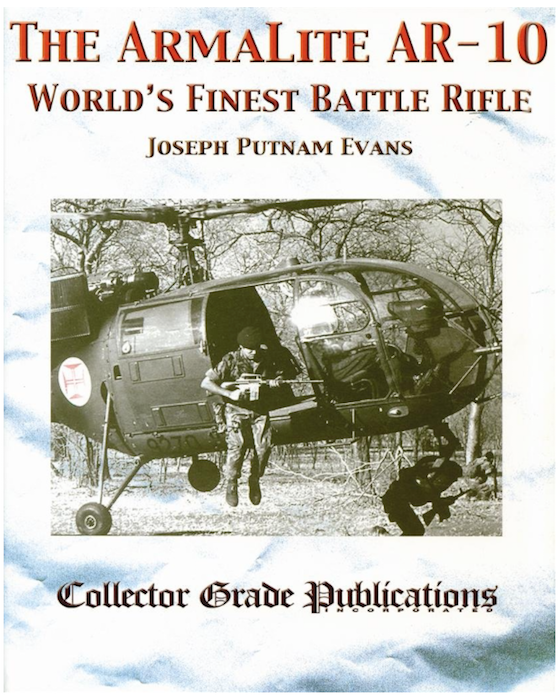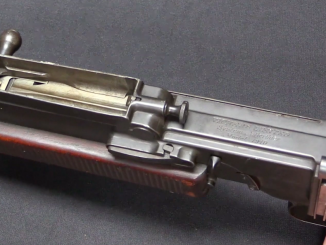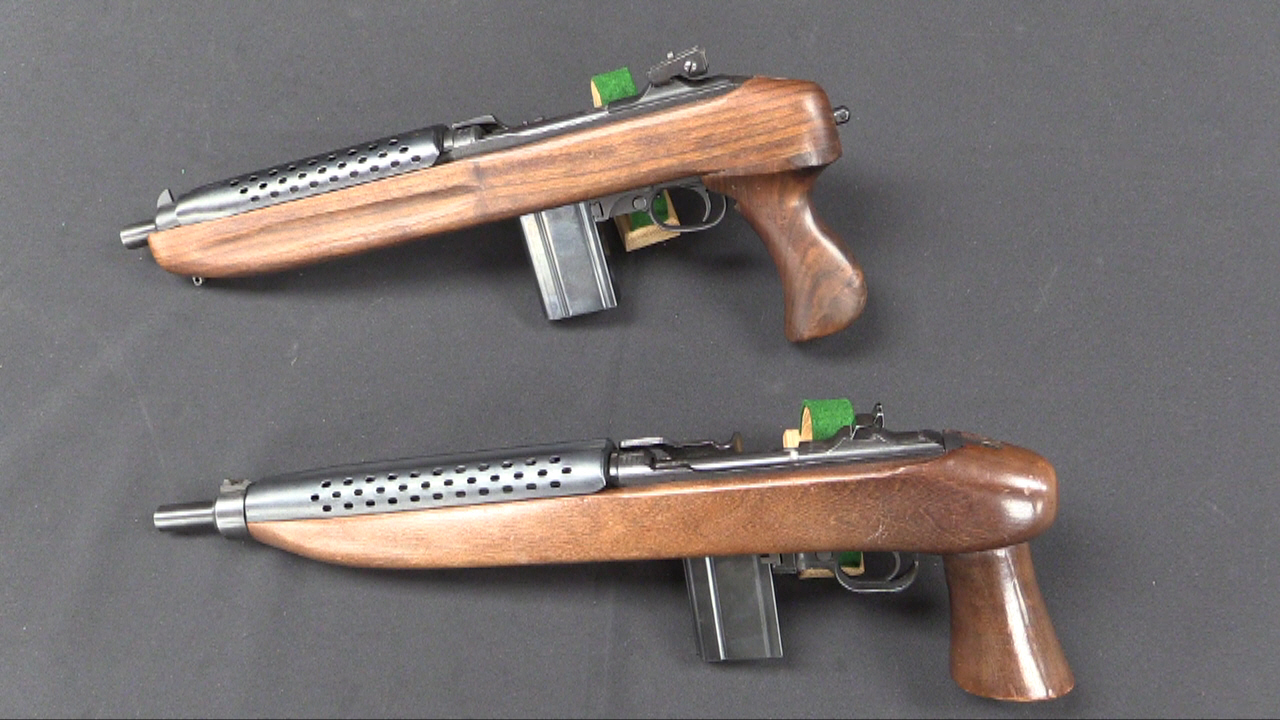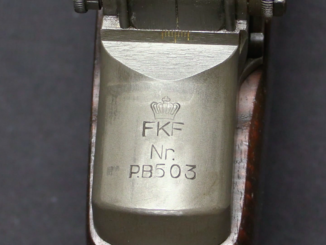 One of the topics that has been (somewhat oddly) lacking a detailed and well-researched history is the Armalite AR-10. There was a book written by a Major Pikula many years ago, but it is really hard to find (I’ve seen it referenced, but never found a copy myself). There is the Collector Grade book on the AR-15 (The Black Rifle), but it has only a scant dozen pages on the AR-10. What we have really needed is for someone to do the research and tell the full story of the Armalite patriarch, the AR-10 – and now Joseph Putnam Evans has.
One of the topics that has been (somewhat oddly) lacking a detailed and well-researched history is the Armalite AR-10. There was a book written by a Major Pikula many years ago, but it is really hard to find (I’ve seen it referenced, but never found a copy myself). There is the Collector Grade book on the AR-15 (The Black Rifle), but it has only a scant dozen pages on the AR-10. What we have really needed is for someone to do the research and tell the full story of the Armalite patriarch, the AR-10 – and now Joseph Putnam Evans has.
The Armalite AR-10: the World’s Finest Battle Rifle was just recently released by Collector Grade, a publisher whose name should be well-known to any arms historian or collector. Personally, I will buy and Collector Grade book sight unseen, because of their outstanding work in the past, and Evans’ volume is no disappointment. At 389 pages copiously illustrated in color, this is right in the middle of length for its type of book. I am very happy to note that it includes an index – the publisher’s apparent distaste for that tool being one of my few complaints with books from Collector Grade.
Anyway, I should be discussing the work itself, not the publisher. What Evans has done is compile a thorough and detailed history of Armalite’s work in the United States and abroad. The book begins with brothers-in-law George Sullivan and Charles Dorchester developing their “Para-Sniper”bolt action rifle and its ideas for super lightweight firearms. At the same time, Eugene Stoner was independently developing his own rifles, and the book explains the paths of both sets of projects and their ultimately serendipitous meeting at the Topanga Canyon Shooting Range.
Descriptions and histories of all the early Armalite project guns follows, including the Para-Sniper as AR-1, Stoner’s .30-06 hunting rifle M7 as the AR-3, the AR-5 Air Force survival rifle,the semiauto shotgun that was the AR-9, and others. The one that really took off, of course, was the AR-10, with a combination of a rotating bolt inspired by Melvin Johnson (whose involvement is detailed) and Stoner’s innovative idea of combining elements of a direct impingement system with a gas piston built into the bolt carrier itself. At this point we reach one of the most interesting parts of the story, to me. Between the initial prototypes and the models ultimately adopted by several militaries there was a winding path of development and change. The rifle’s original raison d’etre was a combination of very effective recoil moderation allowing controllable fire from a very light rifle. The original military prototype was a scant 7 pounds loaded – a weight considered impossible by the Ordnance Department, and yet here Armalite had done it. It was a combination of titanium, aluminum, and (against Stoner’s advice) a composite barrel that made this possible, and it was quite the eye-opener to Ordnance officers.
As always happens, of course, the design became heavier and more robust as it would its way through the testing process. I will leave the sordid detail of its US defeat to Evans, as this takes a substantial portion of the book to explain in proper detail. Ultimately, Armalite would set its sights on Holland and the Dutch firm of Artillerie Inrichtingen to produce its rifle for worldwide adoption. Enter small arms legend Sam Cummings as sales agent, and we have a fascinating story of phone calls to Castro, German WWI lances for the Sudanese Camel Corps, and much more. With each different contract came a slightly different set of customer requirements, and this led to a confusing profusion of different models and details. Evans does an excellent job of identifying, describing, and putting in context each of these different types.
The closing chapters of the book look at a number of examples of notable individual combat use of various AR-10s in conflicts around the world, from Angola and Mozambique to Cuba. Finally, the different semiauto receivers made for collectors over the decades here in the US are each briefly discussed, as are the modern iterations of the rifle, from Knight’s Armament and the new Armalite company.
Overall, Evans has presented a detailed but well-written history of the AR-10 covering all of its major developmental pathways. Even the most knowledgeable collectors will find details within that they did not previously know, and for the great majority of us the book will be massively educational. My only real critique would be that Evans is a bit heavy-handed on his praise of the rifle, especially in the early sections. He is clearly a loving fan of the gun, and it is this passion for the subject that I am sure motivated him to do the research necessary to produce this work. If he fails to always hide that passion behind dry language, I can’t really object too strenuously.
List price for The Armalite AR-10: the World’s Finest Battle Rifle is $79.95, and it can be purchased through Collector Grade directly or via Amazon. It is in print for the time being, but like all Collector Grade books (and all good juicy firearms books in general) it will eventually sell out and become both difficult and expensive to find. I would definitely recommend that anyone interested do themselves a favor and pick up a copy now, while it’s easy. This is definitely a book that has earned its place in your library.




I was lucky enough to have for a couple of years Portuguese-contract serial number A0004, when I lived in Holland. It cost me less in mint condition than a new AR15 would have at the time. The mag housing had been cut away somewhat like a FAL before anodising (it wasn’t one of the AI sporters – the mil marks were simply machined through).
There’s a picture of it still out there on the net: http://www.militaryimages.net/media/ar10-battle-rifle.29483/full with my lovely blue carpet from the time. I later sold it to a collector in Finland (I couldn’t have brought it to Switzerland anyway when I moved here cos it’s a down-converted full-auto).
I really miss that rifle – a joy to shoot, very accurate. I shot it in an IPSC rifle match back in 2006, too 🙂 Super reliable (except the gas regulator that had a tendancy to turn and block off the gas – blue loctite sorted that out), and very soft-shooting.
I would have liked to have still had it to do a video for my shiny new youtube channel: https://www.youtube.com/channel/UC9k2WzcJ1kUMl4KIwNQwrFA
Does sound interesting… not so much the every-known-AR10-detail stuff as the pre-AR-10 background. I had a Charter Arms AR-7 behind the truck seat for a while and it was about as useless a piece of crap as I’ve ever owned, shot, or heard of, and I’ve shot a couple of the new Henry versions that seem to work just fine and actually have a “floating” stock that doesn’t leak and fill with water, which was a detail CA was always confused by. But the one has fascinated me ever since I heard of it, even though I’ve never even seen a picture of one, is the AR-5. (I think they only made 25 of them; something about they were adopted by the Air Force and then the DoD wouldn’t fund production?) But a bolt-action .22 Hornet version of the AR-7 just seems make survival sense, just as much now as in the 50s. Actually even cooler would be a .32-20 version, which would make .218 Bee and .25-20 possible if not very useful for anything practical but would be fun.
“Actually even cooler would be a .32-20 version” of the AR5.
How ’bout .327 (.312″) Fed. Mag.? M1 carbine ballistics, with the ability to also use .32 H&R or, maybe not accurately, .32 S&W long?
“the ability to also use .32 H&R or, maybe not accurately, .32 S&W long?”
Box magazine for various length AND rimmed cartridges. It is even possible? I don’t heard about anything like that.
“M1 carbine ballistics”
Maybe just simply use M1 Carbine? According to http://www.municion.org/
these cartridge are similar in overall length (M1 Carbine even being a bit shorter 42,25mm vs 43,44mm in .22 Hornet) so internal magazine length shouldn’t be a problem. Interesting rim diameters are also quite close (9,08mm in Carbine – 8,66mm in Hornet) so maybe universal extractor claw for both can be crafted.
The main problem would be probably higher pressure in 30 Carbine (40000 in Carbine, 25000 in Hornet, according to SAAMI). Rimless nature of 30 Carbine should promote reliable feeding from box magazine.
“But a bolt-action .22 Hornet version of the AR-7 just seems make survival sense”
During WW2 USAAF used M4 Survival Rifle i.e. .22 Hornet bolt-action repeater.
However now I’m not sure about magazine internal width. Biggest diameter are quite similar for both (9,08mm – M1 Carbine, 8,66mm – Hornet) however I don’t know how looks magazine in AR-7 from top – it is rectangle or isosceles trapezoid following .22 Hornet shape?
Oh, all sorts of possibilities (either .327 or the .357/ .30 Herrett/ .256 Win/ .22 Jet family) but I really doubt if the AR-5 would handle magnums as designed… .32-20 family fit within .22 Hornet pressures and while I’ve never had a .218 I think the .32-20 is perhaps the best all-around revolver round (just a personal fondness, not worth arguing over – fun to shoot and acceptable for defense) and doubt if I’ve ever had a better walk-around-in-the-woods gun than my old bolt-action Savage Sporter .25-20… pretty much the ultimate subsonic 125-yard .22 if that makes any sense.
“I’ve never even seen a picture of one, is the AR-5″http://www.milsurps.com/showthread.php?t=28568&p=163352&viewfull=1#post163352
link: http://www.milsurps.com/showthread.php?t=28568&p=163352&viewfull=1#post163352
The AR7 leaves a lot to be desired. I personally like the Springfield Armory M6 survival gun.
Sounds like an interesting book. For what it is worth, Chuck Taylor’s book on combat rifles from the 1980’s was not very impressed with the AR-10. I think he thought it had issues with reliability and he was of the opinion that it was anything but the ultimate battle rifle. Does anyone have any info on the field reliability of the original AR-10?
Apart from the Portuguese Air Force Caçadores páraquedistas heliborne light infantry/paratroops–which, like zee Gherman Fallschirmjäger were part of the air arm–in Guinea-Bissau, Angola, and maybe Moçambique too, who else used the AR10 “in the field” to gauge its reliability?
The para-quedistas (BCP 21 in Angola and BCP 31 in Moçambique) and the fuzileiros in Guiné used the AR10. The m961 G3 was still far more prevalent in both units. The caçadores (Army infantry) and comandos either used the m962 FAL or the m961 G3. In any case, the AR10 was highly regarded and used until they wore out and could not be repaired in a cost-effective manner. The Portuguese military was hamstrung by a very tight operating budget, so that precluded further deliveries of the FAL, and the Dutch nixing exports of the AR10 did that rifle in. Those, along with HK’s easy licensing terms, left the G3 as the most cost-effective option.
When I got home I double checked Taylor’s book. My memory was incorrect. It was the early AR15’s he thought had reliability issues. Regarding the AR10 he wrote “Prolific in Angola and a highly prized weapon in that area. An excellent weapon, it is highly accurate and lightweight. Mediocre trigger as issued.”
In a more general vein, let me echo the praise for Collector Grade Books. As far as I’m concerned, they’re the best firearms books today with any sort of wide availability.
Many times I went to the Berea, Ohio gunshow at the Cuyahoga County Fairgrounds JUST to get Collector Grade Books. There used to be a hobby shop in Lakewood, Ohio which had the occasional volume. Both of those sources are now gone, and I too am forced to buy new volumes sight unseen.
Indeed!Unfortunately, Collector Grade does not have any retailer left in Europe, which is sad for this means I must order directly from them, which equates to higher postage fees…
Personal opinion: I have shot the M14 in all Designated Marksman versions, the SR-10, Mk-11, M-21 and SR-25. I have neither shot nor held a KAC XM110 that I remember due to its late date of development (early 2000s if memory serves) and acceptance, but keep in mind that at 77 years my memory is suspect at times. My by-far preference in repeating rifles of this class is the various versions of the M-14, the AR-10 and the SR-25 (Stoner Rifle-25). Either is readily capable of work out to extended ranges with more than adequate accuracy. They have the advantage of rapid follow-up or multi-target capabilities over the various iterations of the Rem. Model 700 variations while exhibiting comparable accuracy. As long as one follows the prescribed maintenance requirements, none of these rifles exhibit any negative qualities one will at times hear about.
Sorry; I hit the “N” key instead of the “B” key in name slot. I TOLD you folks that all my gears are slipping!!!
Welcome to the club
Tell me about it… Key stroke errors happen a lot at my place of employment.
Wasn’t the Garand action prone to jamming in mud just like the original M16? In fact, it seems hilarious that the French MAS-49/56 actually worked really well in the same jungle where many Green Berets would have gladly exchanged their M16’s for AK’s. And the Browning M1918 also would work well in the jungle had the barrel and gas cylinder been lined with chrome to prevent corrosion and rust… Or am I wrong?
SAY SOMETHING!!!!
“exchanged their M16’s for AK’s”
So far I know low reliability of early M16 was caused, because wrong powder was used for filling cartridges.
… and lack of chrome in barrel and initial false maintenance instructions.
Which leads me to question: was AR10 chrome-lined? I suspect not, unless it was Portuguese version.
Only the chambers were chrome lined, one of the weak points in the design. The other two weaknesses were the plastic butt stocks and the magazines.
Not to worry! If we make it that far (I am not much behind) we will be all at the same “performance level” 🙂
Does Collector Grade Publications allow the authors to retain copyright, or require them to relinquish all rights to the publisher?
That’s something I check before buying a book (and a reason I avoid mail-order books).
I am not at all pleased that many of my images have been used without my consent or even with credit. I am not the only person or entity that is unhappy with this aspect of the publications use of
others images. This is being addressed with those whom are responsible. Joe contacted me to access my collection and I choose not to provide information. I was unconformable with his approach and his methods. Others felt the same way and contacted me in that regard.
Love de cover pic of the book with the portuguese ”paratrooper-hunters” and the Alouette III heli.
A lot of interesting weapons were used by the portuese, HK21 machine guns, the 9mm FBP submachine gun come to mind.
And the Uzi, P-38, MG-42, G3, FN FAL, Kar 98k, even the Madsen LMG. An eclectic mix for sure. A Guerra do Ultramar is a fascinating conflict to study.
I am very excited about this book. I have always wanted a “real” AR 10 (I don’t consider my 16″ POF an AR 10) ever since I got to handle a Dutch rifle built on a Sendra receiver many moons ago. The retro ARs have always been my favorites, although the early AR 10s do look like they could have some potential reliability issues as they seem just heavy enough for the 7.62 x 51mm to function in. Seems the reliability problems have been taken care of with the newer models.
I understand ,I like the old school AR’s too. I won’t own one of the super trendy, hyped up, tacticool AR’s of today. You just can’t find them in full length, non detach carry handle and non garbage rail anymore.
Original AR-10’s are no longer rifles, they’ve become damned status symbols.
The problem with the original AR-10’s is that they are now so expensive the average enthusiast can’t afford them any longer. When I first got into AR-10’s they were less than a 50.00 Belgium FAL, pricey, but reasonable. Now there are basically two kinds of AR-10 owners: those who’ve had them for decades, and those who will pay truly incredible amounts of money to own one. The result is riflemen and shooters will never get a chance to fire an AR-10 much less own one. When I hung a $12k “Buy it now” on my Portuguese Sniper (an amount I never thought I’d get) I was shocked when it sold in less than a day.
It’s ironic that the book about the AR-10 costs about what it costs to make an AKM.
Plenty of people in the former Soviet sphere “went without” because the central planners wanted those AKM parts making as part of their five year plan.
With the book, you get to pay the full price – should you choose to buy it.
The people who went without, due to the capriciousness of central planning, didn’t get a choice.
This is low print volume book. I bought years ago Black Rifle (M16 story) and paid about as much.
Bugger I’m getting old, I contributed to ‘The Black Rifle – M16 Retrospective’ book back then as well!
I got to handle and photograph AR15 prototypes #2 & #3 that Jacques Michault had in the small display room at the Sidem UK HQ in Bridgewater, Somerset. When Sidem closed operations in the UK (around 1996) Jacques wanted to ‘gift’ the prototype rifles to the Smithsonian Museum… the declined them!!! They were sold to a collector in the USA for $5,000. Just last year they were sold on for $125,000 each!
I suspect that I could have bought them back in 1985 (when I photographed them) for around $1,000 each… Ah well!
As a contributor to the book, I got to speak with Joe a lot about my experiences with ‘surplus’ AR10’s back in the 80’s and also my talks with Jacques Michault of Sidem and his involvement with the story. I also had information on the parallel BM-59 rifle being developed by Beretta at the time and AI’s involvement with a ‘Dutch’ version, a sort of BM-59 ‘a-like’ that used AR10 magazines. I was happy to share the information as I am a firm believer that information should be shared and not hoarded, unlike a lot of historians who jealously hold on to information and ultimately take it to the grave with them!
A lot of the information hoarding has nothing to do with “historians” but rather is centered around egocentric (you can substitute egotistical) personalities. It is matter of narcissistic individuals who inflate their importance by the belief they have “knowledge ” of something that others don’t. They more others learn the less important they are, thus their self-appointed Olympian status is at risk.
I second Vic’s comment. This book brings together a great deal of information which prior to could only be found in a multitude of other sources (many out of print or only found online). I am fortunate enough to own two of these magnificent rifles (with 1980’s produced lower receivers). They are lightweight, accurate to 1.5 MOA, and well balanced. Thanks to Joe for keeping the information alive.
“My only real critique would be that Evans is a bit heavy-handed on his praise of the rifle, especially in the early sections.”
I have to concur. I was given a copy of the book and Mr. Putnam clearly has spent a lot of time and done a great deal of laudable research, but the AR-10 is not Excalibur and not “Old Hickory”. it’s just a rifle-a great rifle but still a rifle. An INFANTRY rifle. As such the performance of a military combat rifle should be examined and judged from the perspective of an infantry soldier. The cruel fact is collectors, gun nuts, dealers, and enthusiasts who never carried a rifle in harms way view military arms from a romantized and often naive perspective.
Superb review, Ian. We currently offer this book on our website, abramsantiques.com, along with hundreds of other militaria and firearms reference books.